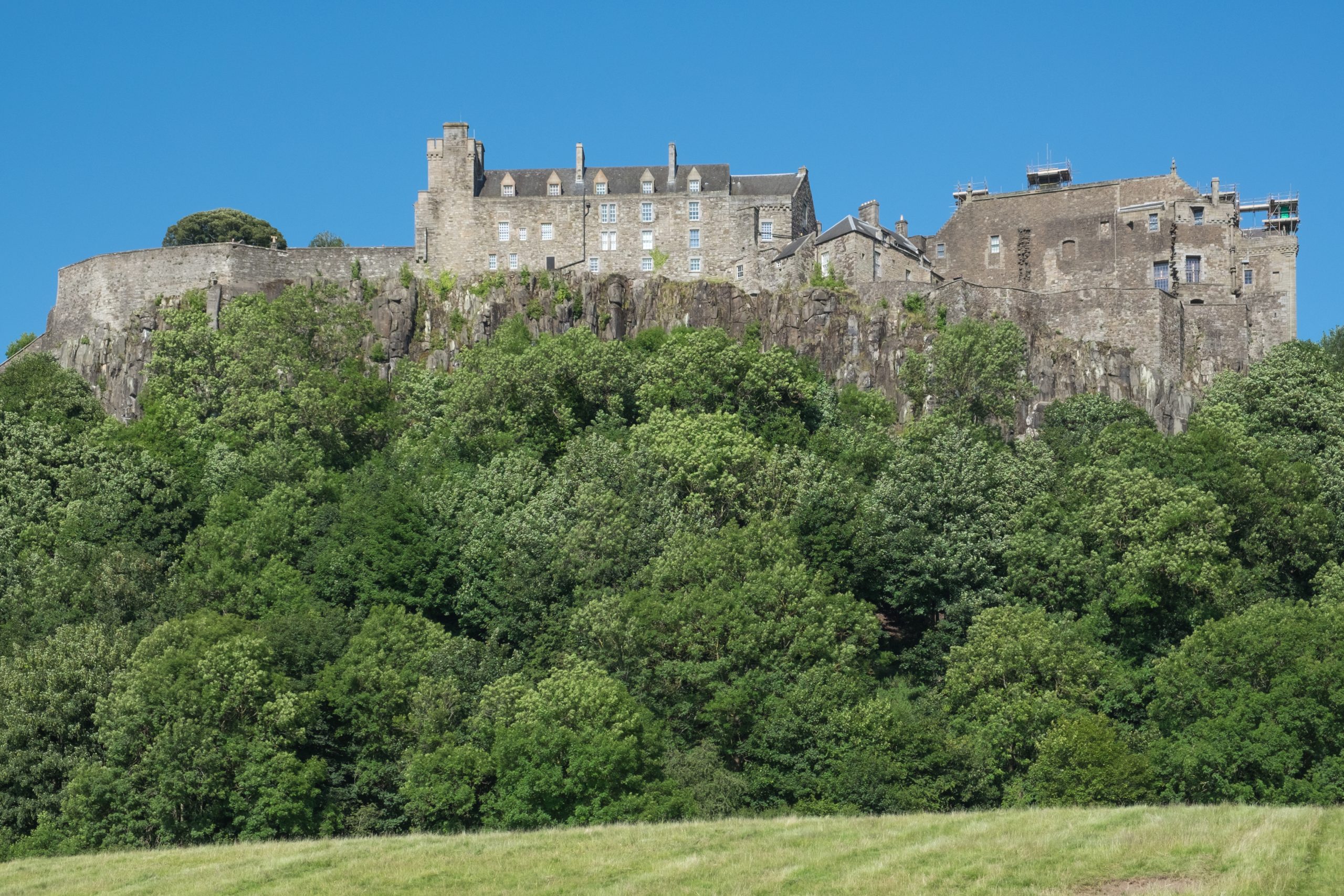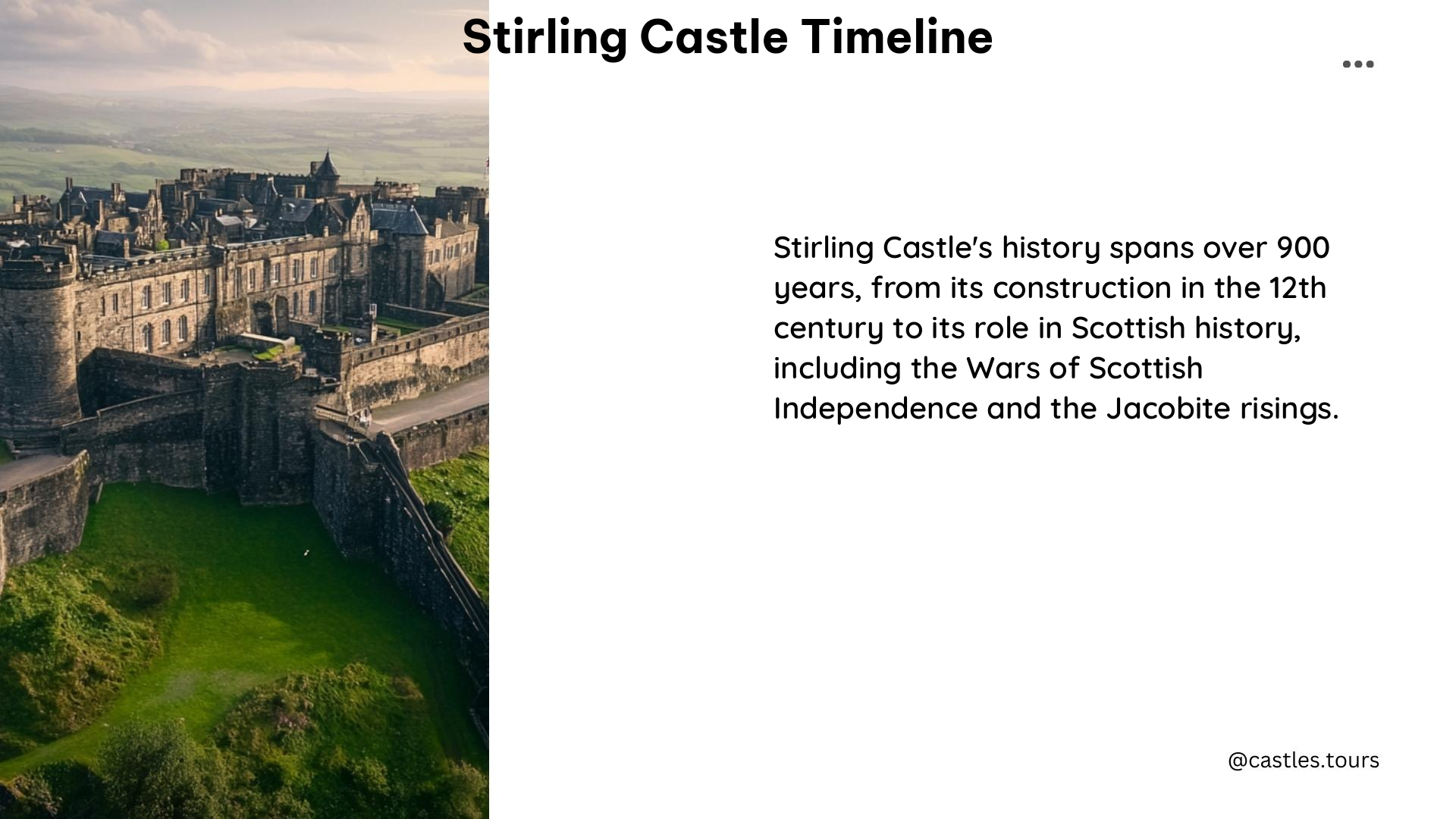Stirling Castle, located in Stirling, Scotland, is one of the most historically and architecturally significant castles in the country. Its timeline spans over 900 years, from its earliest recorded mention in 1110 to its present-day status as a popular tourist attraction. This comprehensive blog post will take you on a captivating journey through the castle’s rich history.
Early History (1110-1296)

- 1110: The first record of Stirling Castle dates back to this year, when King Alexander I dedicated a chapel there.
- 1214: William I dies at Stirling Castle.
- 1263: Alexander III creates additional hunting parks to the south of Stirling Castle, near Bannockburn.
- 1280: Extensive building work is undertaken at the castle, none of which remains.
- 1291: Stirling Castle is placed under the control of Edward I of England while he adjudicates the future of the Scottish Crown.
- 12 July 1291: The Scottish nobility swears fealty to the English Crown at Stirling Castle.
- 1296: Edward I captures an undefended Stirling Castle.
Wars of Scottish Independence (1297-1356)

- 11 September 1297: William Wallace and Andrew Murray lead the Scots to victory at the Battle of Stirling Bridge below the castle.
- September 1297: Stirling Castle is surrendered by the English to the Scots in the aftermath of the Battle of Stirling Bridge.
- 1298: The Scots abandon Stirling Castle after their loss at the Battle of Falkirk, and Edward I again resumes control.
- 1299: Robert the Bruce successfully lays siege to Stirling Castle and regains it from the English.
- 1304: Edward I of England lays siege to Stirling Castle, but it withholds the attack.
- 1314: English forces attempting to relieve Stirling Castle are resoundingly defeated at the Battle of Bannockburn, two miles to the south of the castle.
- 1336: The English recapture Stirling Castle.
- 1342: The castle finally falls back into Scottish hands.
Royal Residences and Battles (1400-1700)
- 1424: Stirling Castle is part of the jointure (marriage settlement) given to James I’s wife Joan Beaufort, establishing a tradition which later monarchs continued.
- 1452: James II invites the 8th Earl of Douglas to dinner and stabs him to death at the castle.
- 1500: Work begins on building the Great Hall at Stirling Castle, completed in 1504.
- 1503: Work is underway on the Forework, a massive series of defensive towers and walls at the south end of the castle.
- 1542: Mary, Queen of Scots, is crowned at Stirling Castle.
- 1540s: The royal palace is built for James V.
- 1566: Mary Queen of Scots’ son, the future James VI, is baptized at Stirling Castle.
- 1571: Stirling Castle is attacked by Mary’s supporters.
- 1578: A meeting of the Scottish Parliament is presided over by James VI in the Great Hall at Stirling.
- 1584: Rebellious Scottish lords seize Stirling Castle, then surrender it to the King and his army.
- 1594: James VI orders the rebuilding of the Chapel Royal, the building on view today.
- 1617: Stirling Castle is refurbished in advance of a visit by James VI.
- 1627: The castle gardens are redesigned, including the construction of the King’s Knot in the valley below.
- 1633: Charles I visits Stirling Castle during the Scottish tour that forms part of his belated coronation as Scottish Monarch.
- 1650: General George Monck lays siege to Stirling Castle on behalf of Cromwell, and the badly damaged castle surrenders on 14 August.
- 1685: Stirling Castle officially becomes a military base rather than a Royal Palace.
- 1689: New artillery batteries are built, and the old kitchen range is infilled to provide a secure base for guns.
Jacobite Risings and Later History (1700-1800)
- 1700: The Palace is rebuilt to include an upper level of accommodation for the Castle Governor.
- 1711: Work begins on the strengthening of Stirling Castle’s defences in light of the Jacobite threat, finished in 1714.
- 1715: The Government commander in Scotland, the Duke of Argyll, bases himself at Stirling Castle to prevent the advance south of the Jacobite army.
- 1746: The Jacobite Army under Bonnie Prince Charlie takes the town of Stirling and sets up its artillery on Gowan Hill to besiege the castle, but the castle’s artillery destroys the attacking guns and the Jacobites retreat.
Restoration and Tourism (1800-Present)
- 1990s: The Chapel Royal and the Great Hall are restored.
- 2001-2011: The entire royal palace undergoes a painstaking restoration.
- Present: Stirling Castle is a tourist attraction managed by Historic Environment Scotland, featuring the restored royal palace, the Great Hall, and the Chapel Royal.
Key Battles and Events
- Battle of Stirling Bridge (1297): William Wallace and Andrew Murray lead the Scots to victory over English forces.
- Battle of Bannockburn (1314): Robert the Bruce defeats Edward II, securing a significant victory for Scotland.
- Battle of Sheriffmuir (1715): The Duke of Argyll defeats the Jacobite army, preventing their advance south.
Influential Figures
- Mary Queen of Scots: Crowned at Stirling Castle in 1542 and spent much of her childhood there.
- Robert the Bruce: Successfully laid siege to Stirling Castle in 1299 and had its defences destroyed to prevent it falling into enemy hands again.
Cost and Timings
- Admission Prices: Vary depending on the time of year and visitor type, but generally range from £16 to £19.50 for adults.
- Opening Hours: Typically from 9:30 am to 6:00 pm, with extended hours during peak season.
Directory and Contact
- Address: Stirling Castle, Stirling, FK8 1EJ, Scotland.
- Phone Number: 01786 450000.
Value and Significance
- Historical Significance: Stirling Castle has been a key stronghold in Scottish history, with many royal dramas unfolding within its walls.
- Architectural Significance: The castle features a mix of medieval and Renaissance architecture, with many buildings dating from the 15th and 16th centuries.
References
- Britannica. (n.d.). Stirling Castle | History & Facts | Britannica. Retrieved from https://www.britannica.com/topic/Stirling-Castle
- TimeRef. (n.d.). Stirling Castle – Medieval and Middle Ages History Timelines. Retrieved from https://www.timeref.com/places/stirling_castle.htm
- Wikipedia. (n.d.). Stirling Castle – Wikipedia. Retrieved from https://en.wikipedia.org/wiki/Stirling_Castle
- Undiscovered Scotland. (n.d.). Stirling Castle Timeline – Undiscovered Scotland. Retrieved from https://www.undiscoveredscotland.co.uk/stirling/stirlingcastle/timeline.html
- Historic Environment Scotland. (n.d.). Stirling Castle: History | Historic Environment Scotland. Retrieved from https://www.historicenvironment.scot/visit-a-place/places/stirling-castle/history/.
